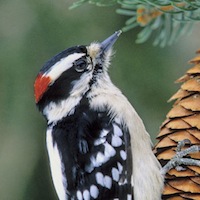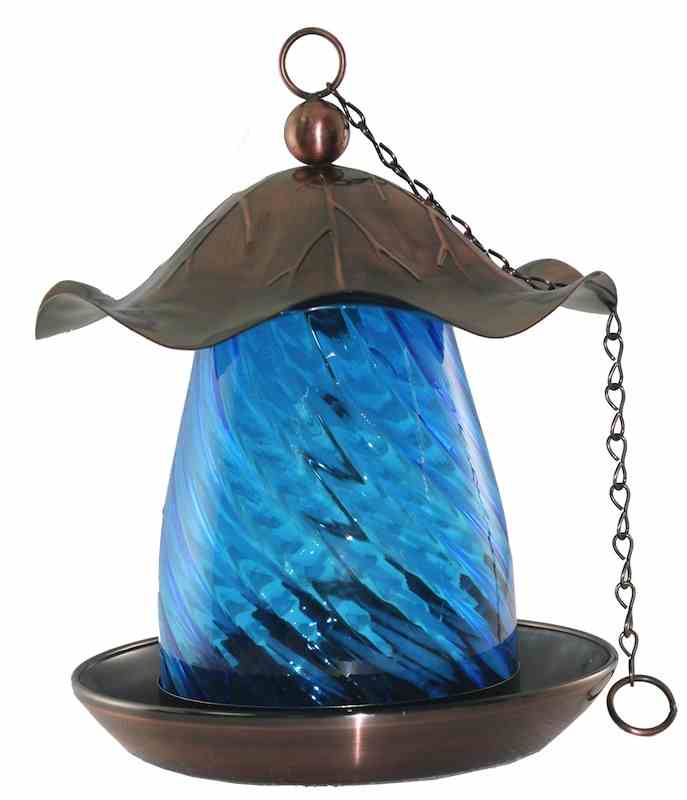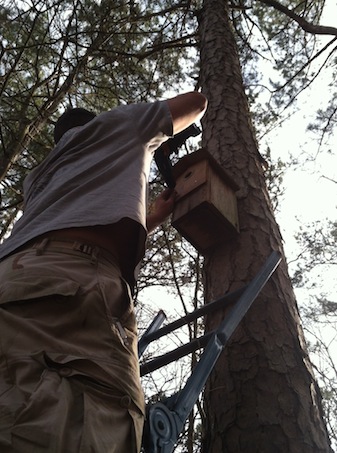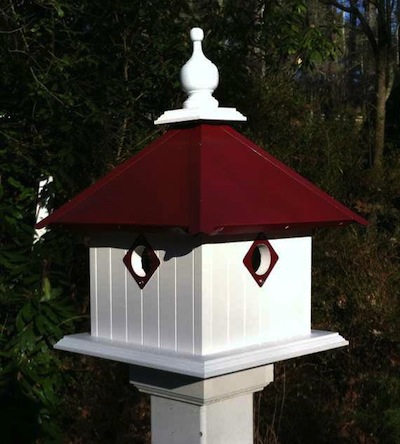-
What’s Your Count? Here’ Ours-Sans the New Glass Bird Feeder
We counted on Monday, the last day for the 2014 Great backyard Bird Count. Had the event been last week-during the ice storm, more species would’ve been recorded. A warm sunny day saw a bit less activity at feeders than the first half of February when treacherous weather brought a slew of new visitors to this North Georgia yard. But with this warmer weather and the first glimpse of spring… a new glass bird feeder or two always helps to celebrate!
Stationary, the count was limited to the backyard where most of our feeders and baths are placed. Superior habitat occurs with mature pines, shrubs and hardwoods. By the way, the greatest benefit to glass feeders is the non-porous surface. Bacteria and mold can not penetrate surfaces like wood, this makes them healthier for birds. Plus they’re much easier to clean.
 But back to the count: Again this year, participation increased over last with 131 countries reporting checklists, as opposed to 110 last year. Although data is still being entered, here’s a brief overview of country, number of species reported, and the number of checklists for that country. Pretty impressive!
But back to the count: Again this year, participation increased over last with 131 countries reporting checklists, as opposed to 110 last year. Although data is still being entered, here’s a brief overview of country, number of species reported, and the number of checklists for that country. Pretty impressive!United States 643 112,281
Canada 234 12,340
India 806 3,195
Australia 492 854
Mexico 658 451
Costa Rica 554 165
United Kingdom 155 150
Puerto Rico 113 150
Portugal 177 134
Honduras 335 104Here’s our list for a 30 minute count: 22 species… not too shabby 🙂
- Mourning Dove 4
- Red Bellied Woodpecker 1
- Downy Woodpecker 1
- Hairy Woodpecker 1
- Eastern Phoebe 1
- Blue Jay 2
- Carolina Chickadee 3
- Tufted Titmice 6
- White-breasted Nuthatch 2
- Brown-headed Nuthatch 1
- Carolina Wren 2
- Eastern Bluebird 2
- Chipping Sparrows 9
- Cardinal 6
- Robin 3
- American Goldfinch 11
- Eastern Towhee 2
- White-throated Sparrow 1
- Pine Warbler 8
- Yellow-rumped Warbler 2
- European Starlings 2
- American Crow 3
Cornell’s data won’t be complete until the end of the month, but they’ve listed some noticeable trends:
Fewer Finches
After last year’s “superflight,” this year’s GBBC reports for 10 irruptive species (mostly finches) are down considerably. This includes reports for the White-winged and Red crossbills, Common and Hoary redpolls, Pine and Evening grosbeaks, Pine Siskin, Purple Finch, Red-breasted Nuthatches, and Bohemian Waxwings. These are believed to be natural fluctuations in numbers because of variation in seed crops.Snowy Owl Invasion Continues
A massive irruption of Snowy Owls into the northeastern, mid-Atlantic, and Great Lakes States of the U.S., as well as southeastern Canada, is easily seen in GBBC numbers. Preliminary results show participants reported more than 2,500 Snowy Owls in 25 states and 7 provinces of the U.S. and Canada!The Polar Vortex Effect
The frigid cold in many parts of North America has resulted in unusual movements of waterfowl and grebes. With the Great Lakes almost completely frozen, some species, such as the White-winged Scoter and the Long-tailed Duck, have fled the frozen lakes and stopped at inland locations where they are not usually found at this time of year.You can still count birds!
Project FeederWatch is a winter-long survey of birds at your feeders. The lab is offering a 2-for-1 to join this fun project now.You can always count birds!
Anytime, anywhere in the world you can report bird sightings through eBird. Use the same user name and password you used for the GBBC and keep on counting at eBird.org.
The Cornell Lab of Ornithology is a nonprofit membership institution interpreting and conserving the earth’s biological diversity through research, education, and citizen science focused on birds. Visit the Cornell Lab website at www.birds.cornell.eduAudubon is dedicated to protecting birds and other wildlife and the habitat that supports them. Our national network of community-based nature centers and chapters, scientific and educational programs, and advocacy on behalf of areas sustaining important bird populations, engage millions of people of all ages and backgrounds in conservation. www.audubon.org
Bird Studies Canada administers regional, national, and international research and monitoring programs that advance the understanding, appreciation, and conservation of wild birds and their habitats. We are Canada’s national body for bird conservation and science, and we are a non-governmental charitable organization. www.birdscanada.org
-
Get ’em Ready: Decorative Bird Houses and Then Some
Okay, so maybe this one’s not so decorative, but it’s popular among downy woodpeckers. In time for nesting season 2014, it’s getting a facelift complete with metal predator guard… thanks to squirrels, and my neighbor, Tom. Because the guard was attached without measuring the roof line (duh!) he re-fashioned it to fit perfectly under the roof. Our downy’s say thank you!
Although it may not seem like it… nesting season is under way! Even though there’s still snow, bird’s instincts tell them it’s time. With just a day or two of warmer temperatures and sunshine, there’s already less activity at feeders and more time spent scouting and claiming nest boxes.
So it’s time to get all possible nesting spots ready for vacancy! You may have to drag your ladder through the snow… what? You’re not crazy like us? Remove old nests, and be sure boxes are in good repair, securely attached to their mounts, with no loose or questionable parts. If the entries have been damaged or enlarged, simply attach a predator guard to remedy. Your birds will be pleased 🙂
Here’s one of our new decorative bird houses that won’t need repair because it’s vinyl and comes with metal predator guards already attached.
In a stunning Merlot color for spring, it’s like a two-for-one, it will host two families in the dual nest compartments. Four entrances with two bedrooms are perfect for chickadees, bluebirds, titmice and other small backyard birds.
Townies, the birds who live in the burbs are more likely to see early successful broods and fledges this year than their counterpart county birds. Townies have it good, with feeders, water and housing offered in many scattered backyards. Country birds have a tougher go of it with the miserable weather and what looks to be, a late spring. We hope for the best.
Competition for nest sites is tough out there!
So to help wild birds thrive, just pick out a new decorative bird house and nab 10% off, plus free shipping on $95 or more for President’s Day (all week)… our thanks for housing the birds 🙂 -
Happy Valentine’s Day… and Thoughts of Spring!
Wishing you a Happy Valentine’s Day
Here’s to thoughts of spring and hungry migrating sprites heading north~
Have your hummingbird feeders ready and filled before they get to your location! We know, with ice storms and and snow everywhere, this seems ridiculous… but it won’t be long before the tiny sprites start their long and exhausting journey!
Staked Mini-Blossoms by Parasol are a fun way to feed and watch these amazing birds. Place them alone or in pairs, in flower pots or right in the ground to catch some antics from a different vantage. Hand blown recycled glass, these feeders last – and hummingbirds love them! Cadmium and lead-free, they’re good for the birds 🙂
Now come on spring!





